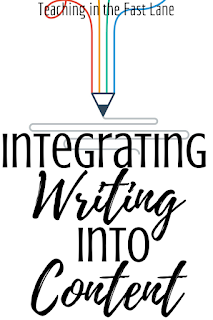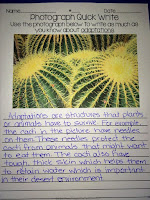Integrated writing is a must in our classrooms. Writing must be integrated into our content areas in order for our students to be successful. We have been hearing this for years. I was told this all the way through teacher college and into my career, but what I was missing was how. No one ever stopped to show me how to integrate writing, so that’s what I would like to do here. Without further adieu, seven strategies for integrating writing into your content areas.
Integrating Writing with Photo Quick Writes
Quick writes are a great way to get students using academic vocabulary. I have a quick write set up that has worked really well for me, especially in science, but can be used for any content area. I display the photo along with a word bank of vocabulary words that students can use to write everything they know about a topic.
This can be done with any photo, but for a no-prep option check out these resources.
Integrating Writing with “Silent” Conversations
Silent conversations are a great way to get students communicating with one another about a topic while holding them accountable for staying on task.
Each student gets a piece of paper and a partner. Once your class is given the topic they each write down a question, thought, fact, or wondering about the topic. After a preset amount of time has expired partners trade papers to read and respond.
This process repeats itself a few times, and then the teacher collects all the papers. I usually end by having students share something insightful that their partner wrote to them or a question that they have.
Integrating Writing with Dice Simulations
Dice simulations are a great way to get students up and moving around the room in order to have a shared experience before starting to write about their topic.
I have completed dice simulations ready to go for you to integrate into your history and science curriculums as well as some that are just for fun!
Integrating Writing with I Wonder Statements
I wonder statements are a great way to get students thinking about a topic before you learn about it in class as an anticipatory set. They are also wonderfully simple to use. You simply instruct students to write down their wonderings about a topic.
I often have students record their wondering statements on sticky notes that we place on chart paper and then revisit at the end of the unit to see if we can answer all of our wonderings.
Example:
Topic: rocks
Why do rocks have different colors in them?
I wonder why some rocks crumble and others are hard.
How come I find rocks in some places and not others?
I wonder how rocks form.
Why do some rocks seem to have lines in them?
Integrating Writing with 3 Minute Non-Stop Writes
I love to treat 3 minutes non-stop writes like a game in the classroom. To get my class all pumped up by challenging them to write for the entire time until the timer buzzes. I may or may not incentivize the whole class participating for the whole 3 minutes, especially at the beginning of the year.
 For a successful 3 minute non-stop write I begin by giving the class the topic and thirty seconds of think time when no one is allowed to write. Then it is time to start. I very dramatically set the timer for three minutes and announce, “Ladies and gentlemen, start your pencils!!!”
For a successful 3 minute non-stop write I begin by giving the class the topic and thirty seconds of think time when no one is allowed to write. Then it is time to start. I very dramatically set the timer for three minutes and announce, “Ladies and gentlemen, start your pencils!!!”They get so into it! The only thing they have to do is write on the topic for 3 minutes. It can be facts, questions, wonderings, connections. Really anything at all. I usually model this by also writing the entire 3 minutes.
At the end, we take a few minutes to share out what we have written.
Integrating Writing with Prompts
Never forget the power of a good old-fashioned writing prompt. I love to find prompts for historical topics that really put my students in the shoes of a person of that time, especially if we have just read a piece of literature about it.
Integrating Writing by Turning a Multiple Choice Question Into a Prompt
This is an especially powerful tool when preparing for a standardized test. When I am looking at released tests I will keep my eye out for a particularly challenging question. Then I simply cut it out, leave off the answer choices and present it to students as a journal prompt. This allows students to use their own academic vocabulary to explain themselves.
I love to use this strategy in math especially because it causes students to think more about the process, not just the end product.
Want More Quick Teaching Tips?
Subscribe to our newsletter to get our latest blog posts by email.


